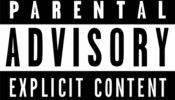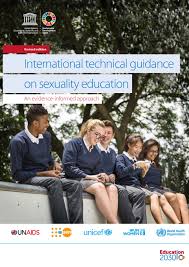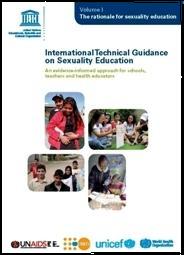2018 Revised International Guidance on Sexuality Education (UNESCO)

International Guidance on Sexuality Education (UNESCO)
TARGET AGE GROUP: 5 to 18 Years
In the newly published UNESCO “International Guidance on Sexuality Education,” UN agencies unite in the all-out effort to take away children’s innocence and destroy our cultures as we know them. CSE is the primary tool used to advance the global sexual rights agenda and is designed to change all of the traditional sexual and gender norms of society by changing the worldviews of children.
The curriculum guidelines clearly show that UNESCO, along with UNAIDS, UNFPA, UNICEF, UN Women, and the World Health Organization (in conjunction with UNESCO’s Education 2030 initiative) is promoting, among other things, gender confusion, promiscuity, abortion, and sexual rights to children under the guise of sexuality education. These excerpts also illustrate the manipulative and subtle, as well as not-so-subtle, manner in which these concepts are promoted to children at impressionable ages.
According to an article published by Devex.com, an aggressive LGBTQI rights advocacy organization, known as OutRight Action International, was also involved in creating these guidelines. The same article also explains that this final, carefully worded version is toned down substantially from what it was originally in order to stave off the backlash from conservative countries. Devex also noted that an original version contained the word “comprehensive” in the title, which was also removed to prevent controversy, even though the term “comprehensive,” as in “comprehensive sexuality education” or CSE was retained throughout the text of the publication.
Also, note the insidious and manipulative manner in which this guidance grooms the minds and hearts of young children. Instead of encouraging children to postpone sexual relations until marriage, these guidelines tell them, among other things, that they can choose when to have sex and that their sexual decisions must be respected.
Curriculum Excerpts
- Distorts Abstinence
- Promotes Sexual Pleasure for Children
- Promotes Early Sex and Promiscuity
- Transgender Ideology & Diverse Gender Identities
- Affirmation of Diverse Sexual Orientations
- Masturbation
- Consent to Sexual Behavior
- Abortion
- Condoms and Contraception
- Diverse Family Forms
- Manipulates Values, Attitudes, and Beliefs on Sexuality
- Radical Feminism
- False Claims About CSE
- Promotes a Right to CSE Information
- Creates Customers for Planned Parenthood
- Misinterprets UN Agreements to Assert a Right to CSE
- Teaches Children to Question Parents’ Values on Sexuality
UNESCO Guidelines Distort Abstinence
“[U]nderstand that abstinence means choosing not to have sex, or deciding when to start having sex and with whom, (Pg. 71, Learning objectives 9-12 years)
“[A]bstinence is not a permanent condition in the lives of many young people.” (Pg. 18, 2.2—Other key considerations in the evolving field of CSE)
“Abstinence-only programmes have been found to be ineffective and potentially harmful to young people’s sexual and reproductive health and rights.” (Pg. 18)
Excerpts that Indicate UNESCO Guidelines Promote Sexual Pleasure for Children
“describe male and female responses to sexual stimulation.” (Pg. 71, Learning objectives 9-12 years)
“Engaging in sexual behaviours should feel pleasurable.” (Pg. 72, Learning objectives 15-18+ years)
“summarize key elements of sexual pleasure and responsibility” (Pg. 72, Learning objectives 15-18+ years)
“reflect on how gender norms and stereotypes influence people’s expectations and experience of sexual pleasure” (Pg. 72, Learning objectives 15-18+ years)
Excerpts that Indicate UNESCO Guidelines Promote Early Sex and Promiscuity
“[Y]oung people want and need sexuality and sexual health information as early and comprehensively as possible …” (Pg. 35, 5.1—Goals, age groups and structure)
“CSE promotes the right to choose when and with whom a person will have any form of intimate or sexual relationship …” (Pg. 18, Other key considerations)
“[R]ecognize that each person’s decision to be sexually active is a personal one, which can change over time and should be respected at all times.” (Pg. 71, Learning objectives 12-15 years)
“[D]emonstrate respect for diverse practices related to sexuality” (Pg. 48, Learning objectives 9-12 years)
“[R]cognize that informed sexual decision-making (i.e. being knowledgeable and confident in deciding if, when and with whom to become sexually active) is important to their health and well-being” (Pg. 71, Learning objectives 12-15 years)
“[N]on-penetrative sexual behaviours are without risk of unintended pregnancy, offer reduced risk of STIs, including HIV, and can be pleasurable” (Pg. 72, Learning objectives 12-15 years)
“[S]upport the right for everyone … to express their sexual feelings” (Pg. 78, Learning objectives 12-15 years)
CSE can “help children and young people form respectful and healthy relationships with … romantic or sexual partners.” (Pg. 17, 2.1—What is comprehensive sexuality education (CSE)?)
“aims to equip children and young people …” to “develop respectful social and sexual relationships” (Pg. 16, 2.1 What is comprehensive sexuality education (CSE)?)
“during puberty boys and girls become more aware of their responses to sexual attraction and stimulation” (Pg. 71, Learning objectives 9-12 years)
Excerpts that Indicate UNESCO Guidelines Promotes Transgender Ideology and Respect for Diverse Gender Identities
“explain how someone’s gender identity may not match their biological sex” (Pg. 50, Learning objectives 9-12 years)
“demonstrate respect for the gender identity of others” (Pg. 50, Learning objectives 9- 12 years)
“define gender and biological sex and describe how they are different” (Pg. 50, Learning objectives 5-8 years)
“reflect on how they feel about their biological sex and gender” (Pg. 50, Learning objectives 5-8 years)
“CSE contributes to gender equality by building awareness of the centrality and diversity of gender in people’s lives.” (Pg. 17, 2.1—What is comprehensive sexuality education (CSE)?)
“define homophobia and transphobia” (Pg. 50, Learning objectives 15-18 years)
“analyze social norms that contribute to homophobia and transphobia and their consequences” (Pg. 50, Learning objectives 15-18+ years)
“demonstrate ways to show support for people experiencing homophobia or transphobia” (Pg. 50, Learning objectives 15-18+ years)
Excerpts that Indicate UNESCO Guidelines Promotes Affirmation of Diverse Sexual Orientations
Please note: These quotes related to violence and discrimination should not be interpreted as a Family Watch endorsement of violence. Family Watch has a longstanding policy position that we oppose violence and unjust discrimination against persons based on their sexual orientation or gender identity. These quotes are here as an example of what children are being taught, and often CSE purposely presents LGBTI issues in the context of LGBTI persons as victims, and then goes on to encourage expression of any sexual orientation or gender identity at any age, regardless of the health consequences.
“all people should be able to love who they want” (Pg. 50, Learning objectives 15-18+ years) [Note: While we agree with this statement this is a common mantra used to legalize same-sex marriage.]
“[H]omophobic and transphobic violence is a form of school related gender-based violence” (Pg. 23, Children’s, young people’s SHRH) [Note: While this can be true, and violence should be prevented, CSE proponents have been known to characterize beliefs, such as marriage between a man and a woman or that biological males cannot become females, as a form of hate or violence.]
“severe restrictions and penalties imposed on LGBTI people” (Pg. 25, Lesbian, gay, bisexual, transgender and intersex) [Note: Man/woman marriage laws have been considered to be “severe restrictions” on LGBTI people, and language like this has been used to repeal man/woman marriage laws.]
“discrimination and harm on the basis of their sexual orientation, gender identity or expression” (Pg. 25, Lesbian, gay, bisexual, transgender and intersex) [Note: The problem with this is that CSE programs often define discrimination as rooted in religious beliefs regarding marriage and sex.]
“[H]omophobia and transphobia … lay the groundwork for more vindictive and violent forms of bullying.” (Pg. 25, Lesbian, gay, bisexual, transgender…)
“acknowledge that discrimination against people who are attracted to the same sex, or who are believed to be attracted to the same sex is wrong and can have negative effects on these individuals” (Pg. 70, Learning objectives 9-12 years) [Note: Again, the problem is how discrimination is defined.]
“recall examples of gender bias against men, women and people of diverse sexual orientation and gender identity” (Pg. 50, Learning objectives 15-18+ years)
“Sexuality” encompasses “gender identity; sexual orientation; sexual intimacy; pleasure.” (Pg. 17, 2.1—What is comprehensive sexuality education (CSE)?)
“diversity in the way young people manage their sexual expression” (Pg. 18, Other key considerations in the evolving field of CSE)
Excerpts that Show UNESCO Guidelines Promote Masturbation
“[M]any boys and girls begin to masturbate during puberty or sometimes earlier ….”(Pg. 71, Learning objectives 9-12 years)
“[M]asturbation does not cause physical or emotional harm but should be done in private ….” (Pg. 71, Learning objectives 9-12 years)
Excerpts that Show UNESCO Guidelines Teach Children to Consent to Sexual Behavior
“demonstrate ways to communicate giving and refusing consent” (Pg. 56, Learning objectives 15-18+ years)
“Consent is critical for healthy, pleasurable and consensual sexual behaviour with a partner.” (Pg. 56, Learning objectives 15-18+ years)
Excerpts that Show UNESCO Guidelines Promote Abortion
“Because of the legal restrictions on access to safe abortion that exist in many parts of the world, adolescents often resort to unsafe procedures administered by unskilled providers.” (Pg. 23, Unsafe Abortion)
“[A]dolescent girls … are generally less knowledgeable about their rights concerning abortion and post abortion care.” (Pg. 23, Unsafe Abortion)
“recognize the importance of using contraception correctly, including condoms and emergency contraception” (Pg. 75, Learning objectives 15-18+ years)
“explain that emergency contraception (where legal and available) can prevent unintended pregnancy” (Pg. 75, Learning objectives 12-15 years)
Excerpts that Show UNESCO Guidelines Promote Condoms and Contraception
“demonstrate the steps for correct condom use” (Pg. 79, Learning objectives 12-15 years)
“demonstrate ways to access condoms” (Pg. 80, Learning objectives 15-18+ years)
“demonstrate confidence in discussing and using different contraceptive methods” (Pg. 75, Learning objectives 15-18+ years)
“Many curricula fail to provide adequate information about modern contraception – particularly, but not limited to, emergency contraception and female condoms …” (Pg. 91)
Excerpts that Show UNESCO Guidelines Promote Diverse Family Forms
“As early and comprehensively as possible, learners will be able to express respect for different kinds of families …” (Pg. 38, Learning objectives 5-8 years)
Excerpts that Show UNESCO Guidelines Manipulates Values, Attitudes, and Beliefs on Sexuality
“expectations that govern sexual behaviour differ widely” (Pg. 17, Conceptual framework for sexuality in the context of CSE)
“… CSE includes ongoing discussions about social and cultural factors … such as gender and power inequalities … sexual orientation and gender identity.” (Pg. 18, 2.2—Other key considerations in the evolving field of CSE)
“CSE covers the full range of topics … including those that may be challenging in some social and cultural contexts.” (Pg. 16, 2.1— What is comprehensive sexuality education (CSE)?)
“respect, acceptance, tolerance and empathy, regardless of … sexual orientation, gender identity or expression” (Pg. 17, 2.1—What is comprehensive sexuality education (CSE)?)
“explore values, attitudes and social and cultural norms and rights impacting sexual and social relationships” (Pg. 34, 5.1—Goals, age groups and structure)
“Certain behaviours are seen as acceptable and desirable, while others are considered unacceptable. This does not mean … they should be excluded from discussion within the context of sexuality education.” (Pg. 17, Conceptual framework for sexuality in the context of CSE)
“compare and contrast ways that … religion influence[s] how society views sex, gender and reproduction” (Pg. 65, Learning objectives 12-15 years)
“identify cultural, religious or social beliefs and practices related to sexuality that have changed over time” (Pg. 48, Learning objectives 9-12 years)
“question social and cultural norms that impact sexual behaviour in society” (Pg. 48, Learning objectives 12-15 years)
Excerpts that Show UNESCO Guidelines Promote Radical Feminism
“Sexuality is linked to power … CSE can address the relationship between sexuality, gender and power, and its political and social dimensions.” (Pg. 17, 2.1—Conceptual framework for sexuality in the context of CSE)
Excerpts that Show UNESCO Guidelines Make False Claims About CSE
“Research from around the world clearly indicates that sexuality education rarely, if ever, leads to early sexual initiation.” (Pg. 84, Common concerns about CSE)
“Research has shown that CSE has either no direct impact on the age of sexual initiation, or that it actually leads to later and more responsible sexual behavior.” (Pg. 84, Common concerns about CSE)
Excerpts that Show UNESCO Guidelines Promote a Right to CSE Information
“[E]veryone has the right to accurate information and services … without making judgement on sexual behaviour, sexual orientation, gender identity or health status.” (Pg. 85)
“right to access the [CSE] information” (Pg. 16, Based on a human rights approach)
“Excluding complex issues from CSE renders young people vulnerable and limits their agency in their own sexual practices and relationships.” (Pg. 18, CSE goes beyond education about reproduction, risks and disease)
Excerpts that Show UNESCO Guidelines Create Customers for Planned Parenthood
“There is a need to generate evidence to demonstrate … the demand creation potential of CSE and the provision of youth-friendly SRHR services and commodities.” (Pg. 31, 4.4—What evidence do we need in the future?)
“analyze where condoms and contraceptives can typically be accessed” (Pg. 75, Learning Objective 12-15 years)
“demonstrate ways to access sources of contraception” (Pg. 75, Learning Objectives 12-15 years)
“identify where to access relevant sexual and reproductive health services” (Pg. 63, Learning objectives 15-18+ years
“young people should be able to access affordable, factual and non-judgmental services and support that maintain confidentiality and protect privacy” (Pg. 63, Learning objectives 15-18+ years)
[Note: Planned Parenthood, one of the largest providers of CSE and abortion in the world, and a partner with all of these UN agencies, is cited to 17 times.]
Excerpts that Show UNESCO Guidelines Promote
Please note the difference to respecting people with diverse
Excerpts that Show UNESCO Guidelines Teache Children to Question Parents’ Values on Sexuality
“differentiate between values that they hold, and that their parents/guardians hold about sexuality” (Pg. 46, Learning objectives 15-18+ years)
“acknowledge that some of their values may be different from their parents/guardians” (Pg. 46, Learning objectives 15-18+ years)




